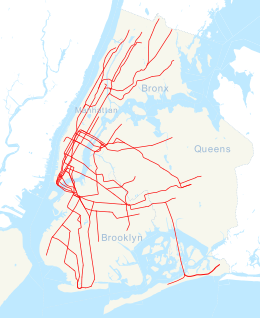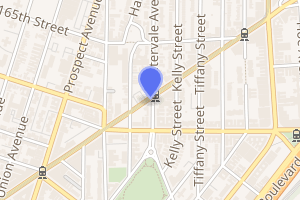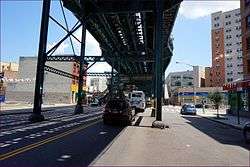Intervale Avenue station
Intervale Avenue (formerly Intervale Avenue–163rd Street[3]) is a local station on the IRT White Plains Road Line of the New York City Subway. Located at the intersection of Intervale and Westchester Avenues in Longwood, Bronx, it is served by the 2 train at all times, and the 5 train at all times except late nights and rush hours in the peak direction.
Intervale Avenue | |||||||||
|---|---|---|---|---|---|---|---|---|---|
Northbound stair | |||||||||
| Station statistics | |||||||||
| Address | Intervale Avenue & Westchester Avenue Bronx, NY 10459 | ||||||||
| Borough | The Bronx | ||||||||
| Locale | Foxhurst, Longwood | ||||||||
| Coordinates | 40.822°N 73.897°W | ||||||||
| Division | A (IRT) | ||||||||
| Line | IRT White Plains Road Line | ||||||||
| Services | 2 5 | ||||||||
| Transit connections | |||||||||
| Structure | Elevated | ||||||||
| Platforms | 2 side platforms | ||||||||
| Tracks | 3 | ||||||||
| Other information | |||||||||
| Opened | April 30, 1910 | ||||||||
| Rebuilt | April 21, 1992 (re-opened after 1989 fire) | ||||||||
| Station code | 431[1] | ||||||||
| Opposite-direction transfer available | Yes | ||||||||
| Former/other names | Intervale Avenue–163rd Street | ||||||||
| Traffic | |||||||||
| Passengers (2019) | 964,689[2] | ||||||||
| Rank | 367 out of 424[2] | ||||||||
| Station succession | |||||||||
| Next north | Simpson Street: 2 | ||||||||
| Next south | Prospect Avenue: 2 | ||||||||
| |||||||||
| |||||||||
| |||||||||
History

The initial segment of the IRT White Plains Road Line opened on November 26, 1904 between 180th Street–Bronx Park and Jackson Avenue.[4][5][6] The Intervale Avenue station opened on April 30, 1910 as an infill station on the White Plains Road Line, and was the first station in the Bronx with escalators. It was built at the cost of $100,000, which was paid with private capital.[7][8] The station was originally served by trains from the IRT Second Avenue Line and the IRT Third Avenue Line, both now demolished. In addition, IRT Lenox Avenue Line trains also stopped at this station.[9][5][10]
The Bergen Avenue cutoff, which allowed Third Avenue trains to access the White Plains Road Line, was abandoned on November 5, 1946, as part of the gradual curtailment of elevated service on the IRT Third Avenue Line.[5] On June 13, 1949, the platform extensions at this station, as well as those on White Plains Road Line stations between Jackson Avenue and 177th Street, opened. The platforms were lengthened to 514 feet (157 m) to allow full ten-car express trains to open their doors. Previously the stations could only accommodate six-car local trains.[11]
Station house arson
On March 15, 1989, three men set the wooden station house on fire after a failed attempt to rob the token booth. The clerk was not seriously injured, while the suspects fled and were never identified.[3][12]
After the incident, New York City Transit considered closing this station permanently due to its close proximity to Prospect Avenue and Simpson Street. However, a community uproar led to the scrapping of the plans.[3] The station was rebuilt with steel canopies and windscreens and a concrete station house with glass block windows and embossed leather-looking walls. Renovations took two and a half years.[13] Artwork called El 2/El 5 by Michael Kelly Williams was installed in the mezzanine and features two mosaic murals depicting underground and elevated tracks. The renovated station reopened on April 21, 1992 after 20 months of work was completed.[14]
Station layout
| P Platform level |
Side platform | |
| Northbound local | ← ← | |
| Peak-direction express | ← | |
| Southbound local | | |
| Side platform | ||
| M | Mezzanine | Fare control, station agent, MetroCard machines |
| G | Street level | Exit/entrance |
This elevated station has three tracks and two side platforms. The center express track is used by the 5 train during rush hours in the peak direction. Both platforms have beige windscreens that run along the entire length and brown canopies with green frames and support columns in the center.
Exits
The station's only entrance is an elevated station house beneath the tracks. Inside fare control, it has two staircases to the center of each platform and a waiting area that allows a free transfer between directions. Outside fare control, there is a turnstile bank, token booth, one staircase going down to the southeast corner of Intervale and Westchester Avenues, and one staircase and one enclosed escalator (both perpendicular from each other) going down to the northeast corner.[15]
References
- "Station Developers' Information". Metropolitan Transportation Authority. Retrieved June 13, 2017.
- "Facts and Figures: Annual Subway Ridership 2014–2019". Metropolitan Transportation Authority. 2020. Retrieved May 26, 2020.
- Blair, William G. (December 26, 1989). "Intervale Pleads for Reopening of El Station". The New York Times. Archived from the original on March 23, 2020. Retrieved October 26, 2015.
- "Discuss Subway Signs in 18th St. Station" (PDF). The New York Times. November 27, 1904. ISSN 0362-4331. Archived (PDF) from the original on March 24, 2020.
- Kahn, Alan Paul (January 1, 1973). Tracks of New York /. New York : Electric Railroaders' Association.
- "Subway Trains Running From Bronx to Battery" (PDF). The New York Times. July 10, 1905. ISSN 0362-4331. Archived (PDF) from the original on March 24, 2020. Retrieved September 4, 2016.
- "New Escalator Subway Station Ready" (PDF). The New York Times. April 28, 1910. Archived (PDF) from the original on April 6, 2019. Retrieved September 22, 2016.
- District, New York (State) Public Service Commission 1st (January 1, 1912). Report of the Public Service Commission for the First District of the State of New York. J.B. Lyon Company, printers.
- "Discuss Subway Signs in 18th St. Station" (PDF). The New York Times. November 27, 1904. Archived (PDF) from the original on March 24, 2020.
- "Subway Trains Running From Bronx to Battery" (PDF). The New York Times. July 10, 1905. Archived (PDF) from the original on March 24, 2020. Retrieved September 4, 2016.
- Report for the three and one-half years ending June 30, 1949. New York City Board of Transportation. 1949. hdl:2027/mdp.39015023094926.
- "3 Men Burn Station In a Failed Robbery". The New York Times. March 16, 1989. Archived from the original on March 24, 2020. Retrieved October 26, 2015.
- "IRT Station to Take 2 1/2 Years". The New York Times. March 17, 1990. ISSN 0362-4331. Archived from the original on May 25, 2015. Retrieved March 24, 2020.
- New York City Transit's Facts & Figures Celebrating 90 Years of Subway Service 1904–1994. New York City Transit. 1994. p. 6.
- "Intervale Avenue Neighborhood Map" (PDF). new.mta.info. Metropolitan Transportation Authority. April 2018. Retrieved February 28, 2019.
External links
| Wikimedia Commons has media related to Intervale Avenue (IRT White Plains Road Line). |
- nycsubway.org – IRT White Plains Road Line: Intervale Avenue
- nycsubway.org — El 2/El 5 Artwork by Michael Kelly Williams (1992)
- Station Reporter — 2 Train
- Station Reporter — 5 Train
- The Subway Nut — Intervale Avenue Pictures
- MTA's Arts For Transit — Intervale Avenue (IRT White Plains Road Line)
- Intervale Avenue entrance from Google Maps Street View
- Platforms from Google Maps Street View




